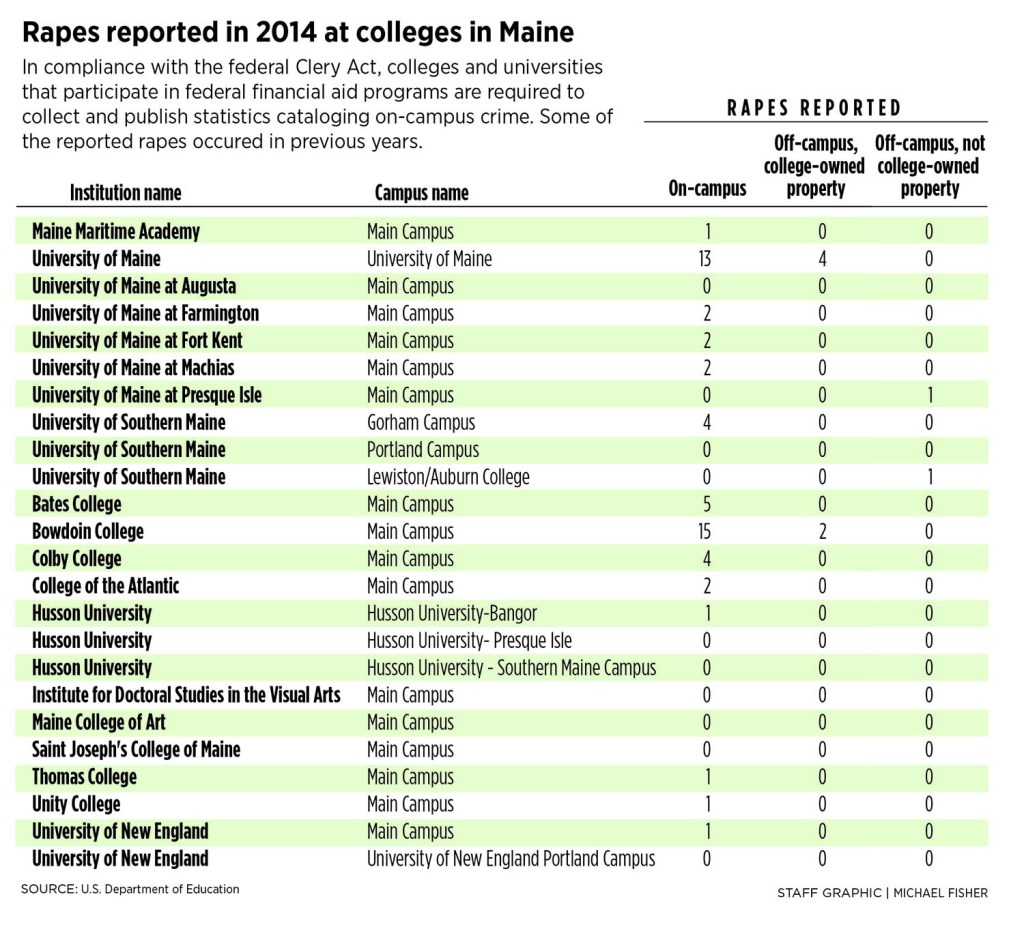Bowdoin College officials say 17 rapes were reported at the school in 2014, a nearly three-fold increase over the previous year that they attribute to heightened awareness on campus and new federal rules about how to report sex crimes.
Bowdoin, which has about 1,730 students, and the University of Maine, which has about 11,000, reported the most rapes among Maine’s colleges and universities last year.
“It’s something we take very seriously here on campus,” said Benje Douglas, who oversees compliance to the new regulations as Bowdoin’s Title IX coordinator. “Our numbers are where they are in part because we’ve tried hard.
“We’ve trained faculty, we’ve trained staff, we’ve trained student workers.”
Douglas said the campus made a big push in 2013 to beef up its reporting on crime statistics, including educating students on how to report such crimes.
In recent years, federal officials have warned colleges to improve training and student education efforts to get more accurate reports of such crimes, which are historically underreported.
All colleges receiving federal funding must report crimes ranging from car theft to murder in annual Clery Act reports to the federal government and posted by law on campus websites.
The 2014 rape statistic may be misleading, Douglas said, because the Clery Act requires campuses to report a rape the year it is reported, not the year it happened. During the campus conversations around new training and education, he said, some students reported being raped in previous years – but they show up in the 2014 statistics.
When asked how many of the 15 reported rapes happened in 2014, he said the college had made a decision to not release that information.
“We don’t want to give students the impression we’re distancing ourselves from the number,” he said. “I think it’s important to let it stand as it is.”
The college reported six forcible sex offenses on campus in 2013, four in 2012 and seven in 2011.
Previously, rape was included in the “forcible sex offenses” category, and amendments to the Clery Act under the Violence Against Women Act added other specific categories. That’s good news and will help long-term efforts to end sexual violence against women, said Anne Hedgepeth, government relations manager with the American Association of University Women.
“In the past few years, we’ve obviously seen a lot of attention on sexual harassment and sexual assault, and I cannot say enough how visibility, student activism and policy response has begun to bring this issue out from under the shadows,” Hedgepeth said.
“This is incredibly powerful information. It tells students their schools are paying attention to the issue, that they have a resource on campus and it tells schools they have a problem,” she added. “A zero does not mean that they have no sexual violence. It means they are not being reported.”
Campuses are at different places in new training and education efforts. Bowdoin began its efforts several years ago, according to Douglas, while the University of Maine System trustees voted in November 2014 to adopt new, more comprehensive, mandatory Clery Act training for staff and students systemwide. Advocates say that with better training and education efforts, reporting increases.
Title IX, traditionally associated with fairness in athletics, also requires that schools actively work to prevent sexual crimes, promptly investigate complaints and discipline the accused if it’s more likely than not that violence occurred.
Send questions/comments to the editors.




Success. Please wait for the page to reload. If the page does not reload within 5 seconds, please refresh the page.
Enter your email and password to access comments.
Hi, to comment on stories you must . This profile is in addition to your subscription and website login.
Already have a commenting profile? .
Invalid username/password.
Please check your email to confirm and complete your registration.
Only subscribers are eligible to post comments. Please subscribe or login first for digital access. Here’s why.
Use the form below to reset your password. When you've submitted your account email, we will send an email with a reset code.